Lost your wedding ring in the yard? I’ve been there.
And believe me, when my wife caught me frantically metal detecting the backyard, I could feel the death stare on the back of my neck.
So I’m writing this from a place of empathy.
And I hope, if time allows, you’ll find your lost ring before having to test out that old ‘never go to bed angry’ thing.
How to Find a Lost Ring in Grass
The best way to find a lost ring in a grass field or backyard is to use a metal detector set to sense its specific metal makeup.
There are other ways to find a ring in the grass, but it’ll be slower than using the speedier detection a metal detector provides.
How, you ask?
Simple. Follow along, and I’ll answer all your questions before it’s too late!
Do Rings Set Off Metal Detectors?
Lucky for you, rings do set off metal detectors quite easily.
A metal detector emits a magnetic field into the ground, and when a metallic ring occupies that area, it sends back a corresponding electromagnetic wave through the detector’s field.
When the complimentary wave disrupts the originating field, the metal detector analyzes the signal data and alerts the user of its finding.
Does that sound complicated?
Trust me, it’s not.
In simpler terms, you turn on the metal detector, and when a metal ring is near, you’ll hear beeping tones from the speaker.
Whether you’ve lost a gold or silver ring, a metal detector can find it.
And even though diamonds aren’t metal and don’t set off a metal detector, the band used to mount the diamond is metal.
Metal Detector to Find Lost Ring

There are so many outstanding metal detectors made for finding lost rings.
For beginners, it’s essential to learn that each type of metal is detectable on a unique frequency. Depending on the metal detector, the frequency or discrimination controls can be manipulated to target the specific metal of your ring.
But for the most part, you can forget about fiddling with all the extras and leave your device in an All-Metal mode.
An All-Metal search mode is precisely what it sounds like.
You’ll pick up anything and everything with an electrically conductive signature.
If you’re in a pinch and need something without the fuss, check out my review of some of the better metal detectors under $100.
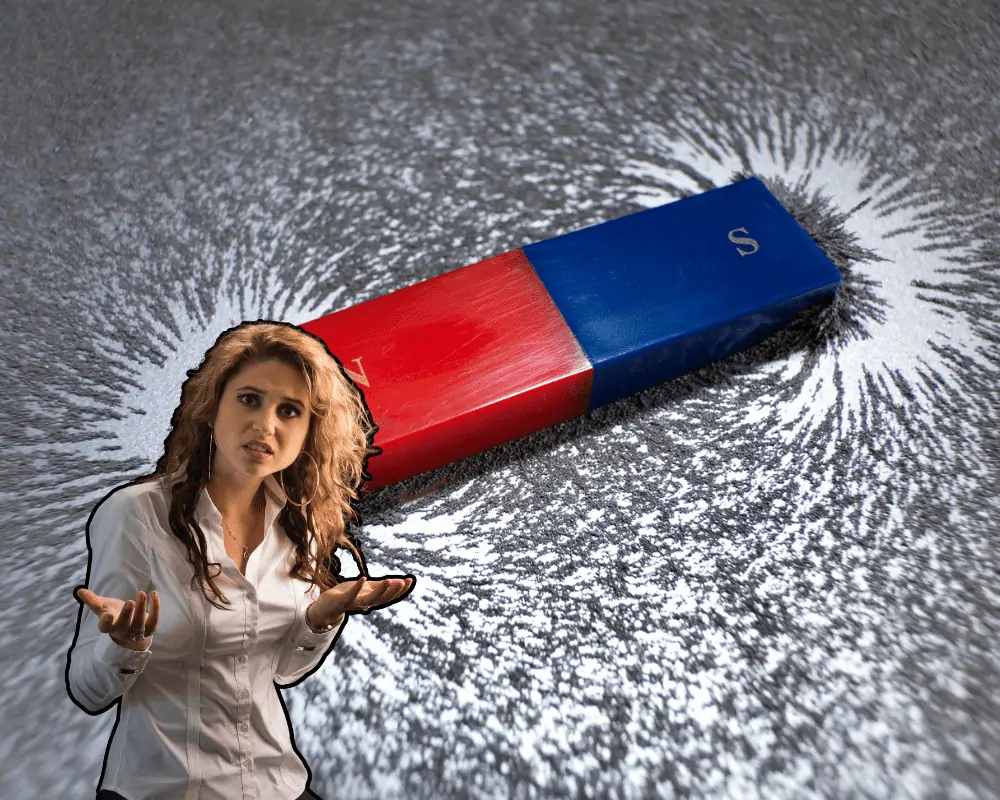
No need to break the bank for a specific job like this. Heck, you could even pick up a small pinpointer to find what you need.
And don’t worry about needing a whole weekend to learn the ins and outs of your new toy.
Most novice detectors are simple turn-on-and-go technology.
But I’ve got you covered if you want a headstart on using a metal detector.
So if this is the route you’re going to take, I’ve got some helpful hints on using a metal detector to find your lost ring based on the metal it’s made of.
Otherwise, skip ahead for my alternative suggestions.
How to Find a Silver Ring in the Grass
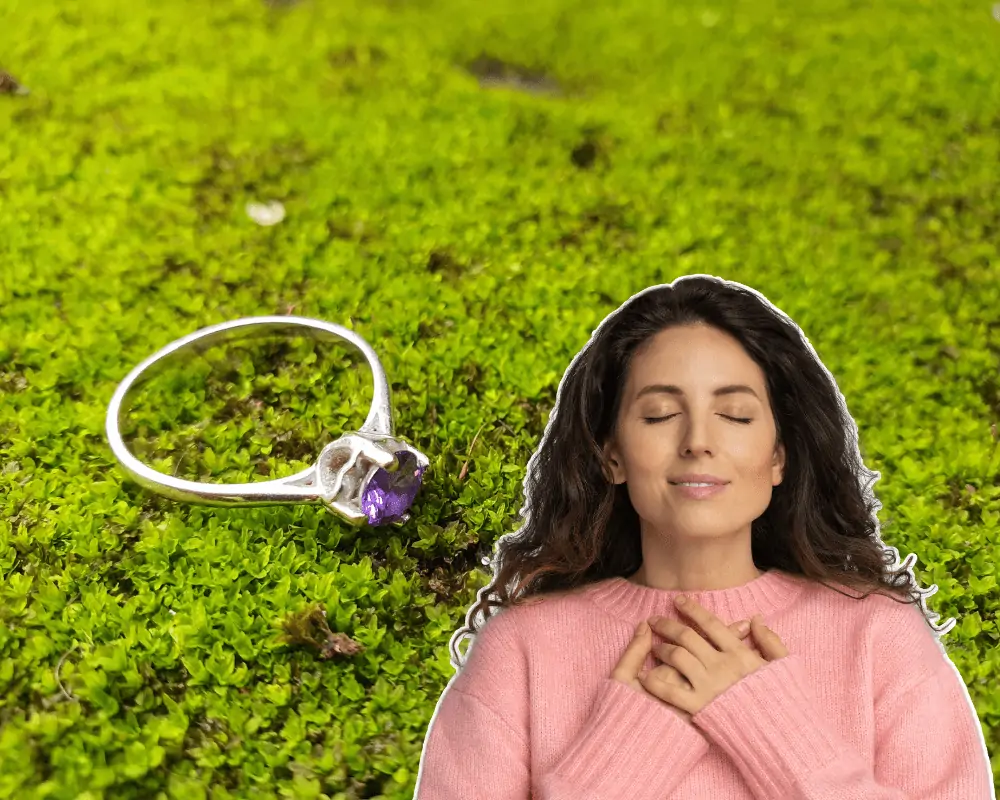
If your lost ring is silver, I’d recommend renting or buying a VLF metal detector, as they usually have a jewelry search mode meant for this situation.
Also, VLF hobby metal detectors have a lower frequency.
And to find a silver ring in the grass, you want to use a frequency of 15 kHz or less.
Lastly, be mindful of your ring’s metal makeup.
It looks silver sure, but is it pure silver? I very much doubt it.
Silver rings are often made with a silver alloy or something else entirely. For instance, your silver ring could be stainless steel, platinum, white gold, sterling silver, palladium, titanium, or tungsten carbide.
Why does this matter?

Well, if you’re using the discrimination controls on your metal detector to find silver, you might filter out these lookalikes. Causing you to miss it altogether.
But as I mentioned before, a catch-all like an All-Metal mode will detect anything hidden in the grass.
Just something to consider.
How to Find Gold Ring in Grass
I lost my gold ring, how can I find it?
Relax!

Gold is a precious metal that every Digger covets. So when it comes to finding gold, you’ve come to the right place.
Just like silver, you should know that your gold ring could contain metals other than gold.
The lower the karat, the less percentage of gold in your ring.
There are also different types of gold, such as pure gold, yellow gold, colored gold, and gold plated.
If your ring isn’t pure gold or 24k, then you can bet other metals like copper or silver alloys are in the makeup of your jewelry.
Again, this matters because each metal has a unique electromagnetic signature.
A VLF metal detector with a frequency of 14 kHz or higher is the best choice to find your gold ring in the grass.
How to Find a Diamond Ring in the Grass

Diamonds are forever, right?
You better find it quick, then.
Unfortunately for you, diamonds are not metal and won’t be picked up by a metal detector.
But…
If the diamond sits on a metal band, you can find your diamond ring in the grass using a VLF metal detector.
The same rules apply to a silver or gold ring.
A VLF metal detector with around 15 kHz is perfect for finding the metal attached to your diamond ring.
How to Find a Tungsten Ring in Grass
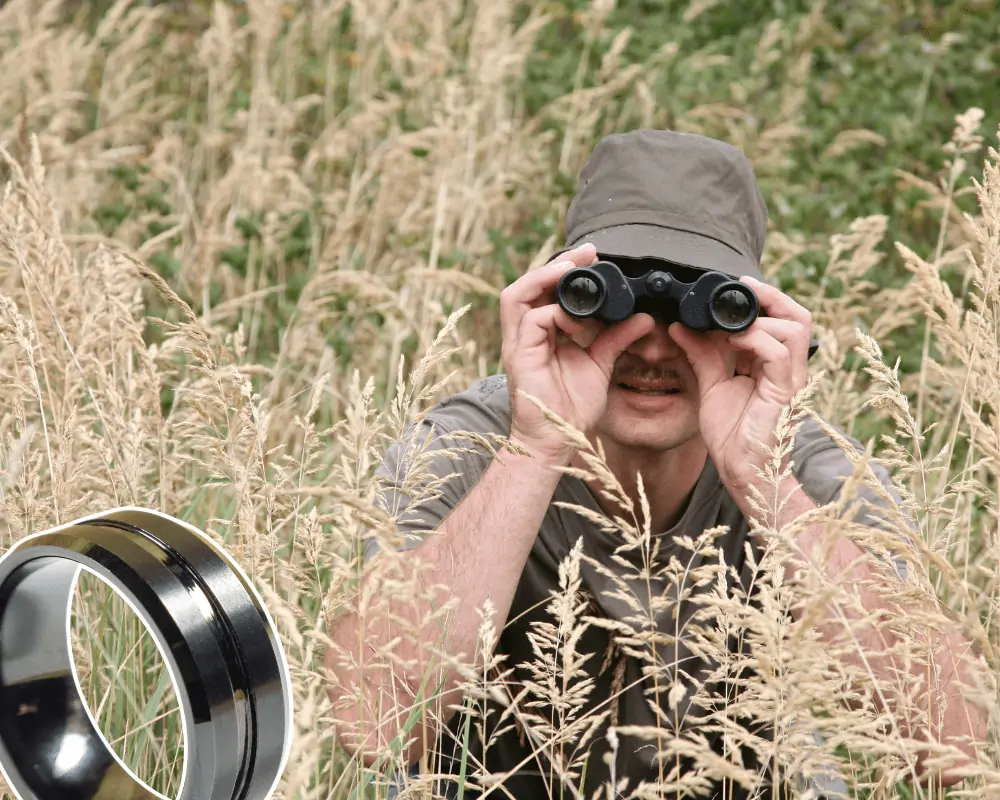
Tungsten is a rare and naturally occurring metal, usually mixed with other metals when used in rings, like nickel.
What’s convenient about losing a tungsten ring is that tungsten is highly conductive to electricity.
In other words, a low-frequency VLF metal detector will easily find a tungsten ring in the grass.
How to Find Ring in Grass Without Metal Detector
While using a metal detector to find a ring in the grass is the most efficient option, you might not have that luxury.
Time is a factor, and waiting for a metal detector to arrive at your doorstep isn’t going to work for you.

You want something you can do now, right?
Well, here are some options to help you find a ring in the grass without a metal detector.
Retrace Your Steps
Sometimes all you need to do is jog your memory a little, and like flipping a switch, it all becomes clear.
You might remember taking your gardening gloves off, which sparks the idea of checking inside them for your ring.
Or maybe no such inspiration comes to mind. But walking the path you took before will put you in all the right areas to find your lost ring.
So keep your eyes peeled and try one of the following suggestions on your stroll.
Let There Be Light

While you retrace your steps, scan the ground slowly and look for any reflection of the light.
Shiny metal bands and diamonds bounce sunlight back up from the grass on a clear sunny day. You just have to be in the right spot to catch these rays of light.
And if you’re stuck with an overcast sky, wait for nightfall and bust out a flashlight for the same desired effect. Only this time, the reflected light might be easier to see.
Be sure to shine the flashlight at an angle and sweep it back and forth as you walk.
Holding the beam straight down won’t ricochet the light as well off the polished metal or gemstones.
Get Up Close and Personal
Your lost ring in the grass is a literal example of a needle in a haystack.

So getting on your hands and knees as you search the ground might be necessary.
Worst case scenario, you’ll search the whole grass field in a grid-like pattern until the ring is found.
Best case scenario, you retrace your steps and get lucky without expanding your search area.
You can try brushing your fingers through the blades of grass or using a metal pipe in hopes of hearing the clang of metal on metal.
Don’t be afraid to get creative.
Ask for Help
When in doubt, become a recruiter.
Ask friends, family, or neighbors for extra hands and eyes to cut your time in half.
The more bodies available to search, the faster you’ll find a lost ring lying in the grass.
This is especially helpful when trying to find jewelry in a wide open grass field instead of a small rowhome backyard in the city.

Use a Small Rake
Using a small rake to find your ring in the grass has its pros and cons.
The hope is to catch the lost ring on one of the tines or teeth of the rake as you pull it toward you.
Another advantage of using a rake is the possibility of hearing the faint sound of hitting metal.
If you’re using a plastic rake, this could be a subtle thump and hard to hear. But if it’s a metal rake, the noise should be more distinguishable.
Now for the downside.
If brushing with a rake too fast, you risk sending the ring flying through the air into a completely different zone.
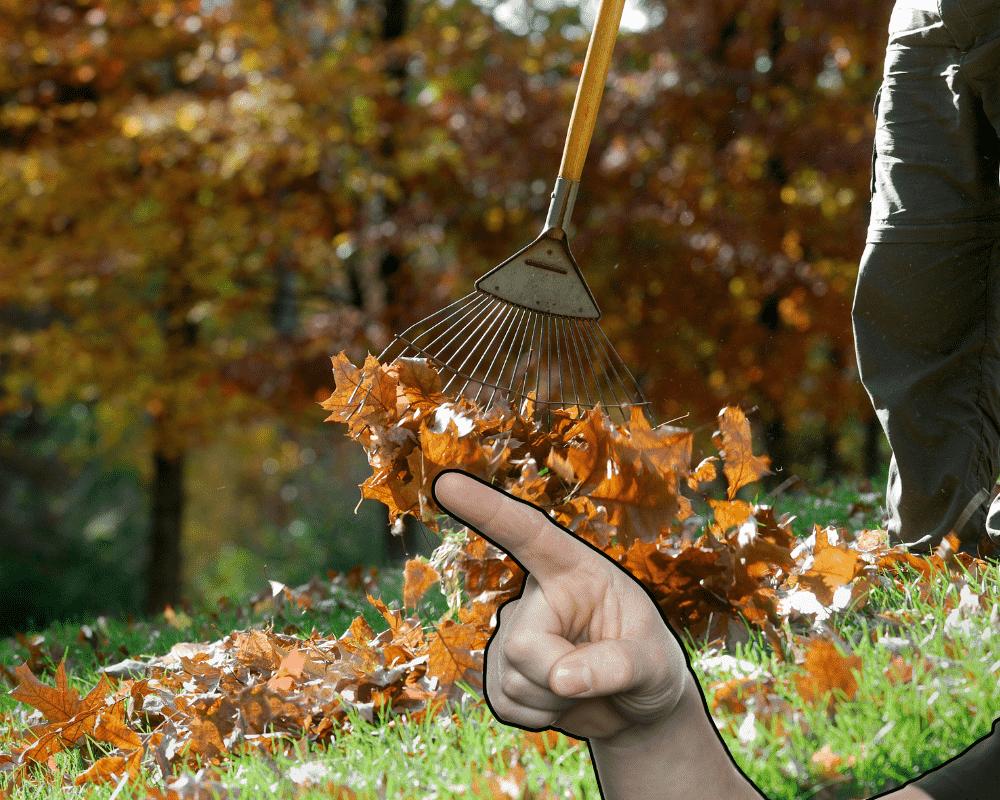
And if you don’t see it launch, you’ll never know you need to adjust your search area.
So, when using a small rake, use steady motions with measured force.
Magnets (Grasping at Straws)
When all else fails, using magnets to find a ring in the grass is a last-ditch effort.
It’s more likely this doesn’t work, but who am I to shut the door on any hope you have left.
You see, most metals used in jewelry are diamagnetic in their purest form. This means they are not attracted to metals.
So why am I suggesting magnets to find your ring?

To be honest, many sources recommend it. And even if I don’t believe it’s very effective, I’d be remiss if I didn’t mention it as a possibility.
While gold, silver, and many other ring metals are not magnetic, most rings use a combination of metals or alloys to improve their quality.
For instance, an 18-karat gold ring has a composition of gold and various alloys like iron and nickel.
It just so happens that iron and nickel are ferromagnetic metals, meaning they are strongly attracted to magnets.
However, with this hypothetical ring, nickel and iron make up less than 25% of its blend.
It’s that low 25% you’re hoping is sufficient enough to seek out the magnet.
FAQs About How to Find a Ring in the Grass

If I’m not the first stop you made in your journey, you’ve probably read some questionable suggestions.
Let me clear some up for you.
Tungsten is a perfect conductor of electricity, which is what a metal detector relies on to find metals in the ground.
Even tungsten carbide, an alloy mixed with a nonconductive carbon compound, will not lose its potent conductance.
However, sometimes a magnet can find a tungsten carbide ring.
It’s not a given since tungsten carbide is paramagnetic, meaning it’s only weakly drawn to a magnet.
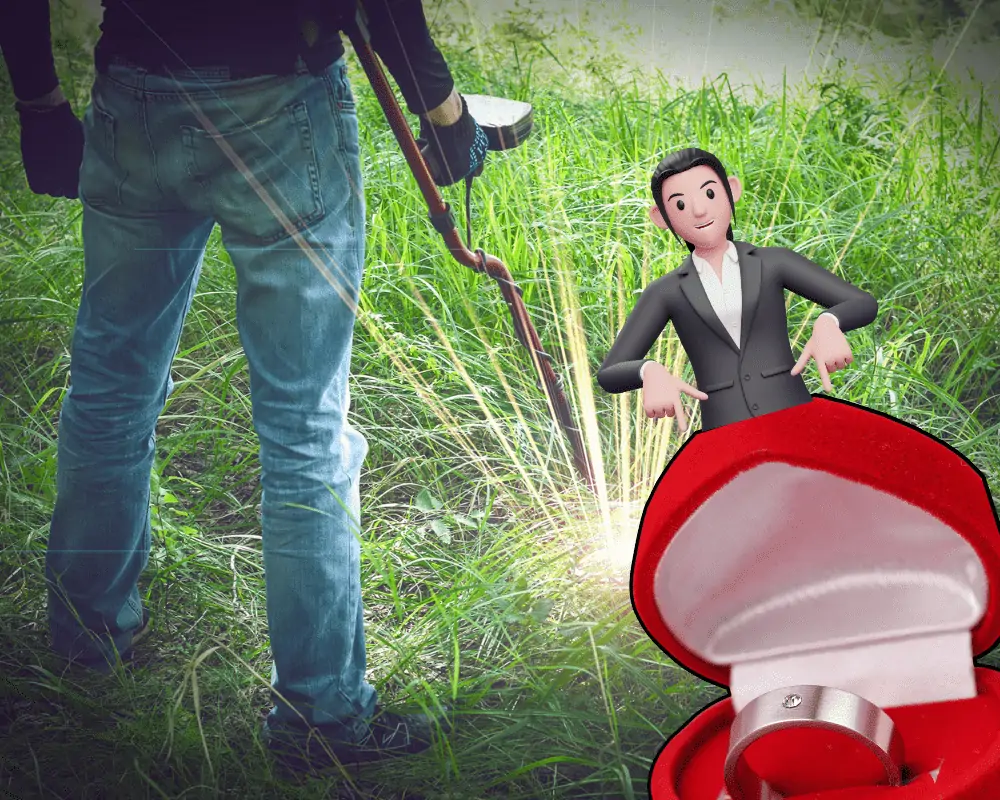
Titanium is one of the poorest conductors of electricity, right in line with electrical steel.
Regardless of its low conductance, you can still detect it as long as you know how to manipulate the sensor of your detector.
Or, you could leave it in the All-Metal mode and still pick it up since it’s just lying in the grass.
I’ve tested a few of them, like Metal Detector by Alexandr Balyberdin.
It works surprisingly well! But you’ll have to get down on hands and knees for a proper response.
If you’re skeptical, download one of the apps and test it before you start.
I think you’ll be impressed.
Happily Ever After

Trying any of these methods should solve your lost ring problem.
Obviously, a metal detector sweeping the grass is the ultimate solution to finding your ring, but there are others.
So pick your poison and start hunting down your misplaced wedding band. Call some friends over and make quick work of it.
I’m rooting for you, and with some luck, you’ll be basking in that massive sigh of relief in no time.

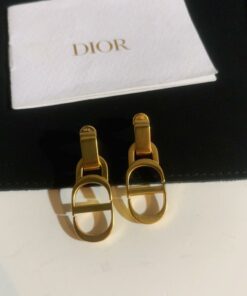 Dior CD Disc-shaped Earrings 2023 Vintage Style for Women
Dior CD Disc-shaped Earrings 2023 Vintage Style for Women  Chanel earrings, CC earrings adorned with pearls v41
Chanel earrings, CC earrings adorned with pearls v41  Chanel earrings, CC earrings adorned with stones v42
Chanel earrings, CC earrings adorned with stones v42 